Economics Report: Bread Price Factors & Obesity Control Policies in UK
VerifiedAdded on 2023/06/16
|13
|2845
|136
Report
AI Summary
This report examines the factors influencing bread prices in the UK, focusing on demand and supply dynamics, including the impact of price, income, consumer preferences, and related goods. It analyzes the structure of the UK bakery market, highlighting the roles of large baking companies, in-store bakeries, and high street bakers. The report also investigates economic policies aimed at controlling obesity in the UK, addressing the rising health costs and prevalence of obesity across different age groups. It discusses various strategies, such as promoting healthy diets, increasing physical awareness, and government interventions, including subsidies and public health campaigns. The analysis uses demand and supply framework to illustrate how shifts in demand affect bread prices and explores policy recommendations for obesity control at both national and local levels.

Running Head: ECONOMICS
Economics
Name of the Student
Name of the University
Author note
Economics
Name of the Student
Name of the University
Author note
Paraphrase This Document
Need a fresh take? Get an instant paraphrase of this document with our AI Paraphraser
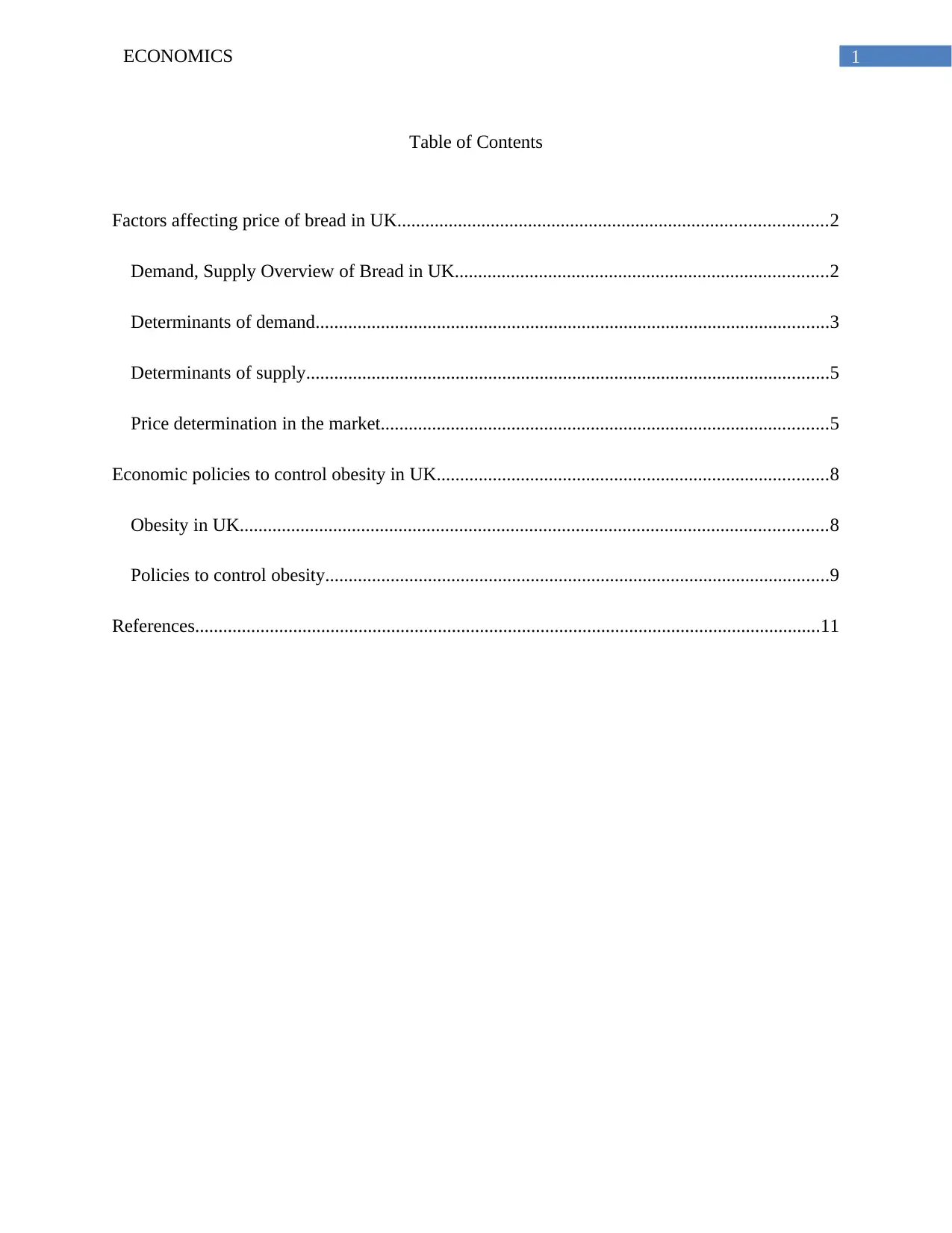
1ECONOMICS
Table of Contents
Factors affecting price of bread in UK............................................................................................2
Demand, Supply Overview of Bread in UK................................................................................2
Determinants of demand..............................................................................................................3
Determinants of supply................................................................................................................5
Price determination in the market................................................................................................5
Economic policies to control obesity in UK....................................................................................8
Obesity in UK..............................................................................................................................8
Policies to control obesity............................................................................................................9
References......................................................................................................................................11
Table of Contents
Factors affecting price of bread in UK............................................................................................2
Demand, Supply Overview of Bread in UK................................................................................2
Determinants of demand..............................................................................................................3
Determinants of supply................................................................................................................5
Price determination in the market................................................................................................5
Economic policies to control obesity in UK....................................................................................8
Obesity in UK..............................................................................................................................8
Policies to control obesity............................................................................................................9
References......................................................................................................................................11

2ECONOMICS
Factors affecting price of bread in UK
In the form of free market economy price of a good is determined based on its demand
and supply condition. Demand of a good signifies ability of a person to buy the goods, which in
turn depends on the purchasing power of the person. The law of demand indicates an opposite
relation between price and demand and hence the demand curve usually slopes downward.
Supply on the other hand represent cost side of the market. The supply curve shows sellers’
willingness to supply in the market. The positive relation between price and supplied quantity
makes the supply curve positively sloped. The demand and supply forces act in the market to
determine price and quantity. To obtain a stable equilibrium supply and demand in the market
should match with each other. Once the price deviates from its original equilibrium position,
there is either excess supply or excess demand in the market. This excess supply or excess
demand cannot persist long in the market. Consumers and producers adjust their demand,
supplied quantity, and bring back the original equilibrium (Case, Fair and Oster 2014). In
presence of excess supply resulted from a price rise, buyers reduce their demand and this pushes
down the price towards equilibrium. With excess demand in the market generated from low price
suppliers restrict supply and price gradually goes up.
Demand, Supply Overview of Bread in UK
In UK, Bakery market is considered as one of the largest and important market for food
industry. The bakery industry in divided into three main sectors. The large baking companies, In-
store bakeries and high retail street bakers (ahdb.org.uk 2017). The large bakery suppliers
dominate the market in both value and volume terms. After large companies in-store bakery
suppliers occupy the second place. Lowest sales volume is observed for high street bakers. These
three sectors together control the supply of bakery in the market.
Factors affecting price of bread in UK
In the form of free market economy price of a good is determined based on its demand
and supply condition. Demand of a good signifies ability of a person to buy the goods, which in
turn depends on the purchasing power of the person. The law of demand indicates an opposite
relation between price and demand and hence the demand curve usually slopes downward.
Supply on the other hand represent cost side of the market. The supply curve shows sellers’
willingness to supply in the market. The positive relation between price and supplied quantity
makes the supply curve positively sloped. The demand and supply forces act in the market to
determine price and quantity. To obtain a stable equilibrium supply and demand in the market
should match with each other. Once the price deviates from its original equilibrium position,
there is either excess supply or excess demand in the market. This excess supply or excess
demand cannot persist long in the market. Consumers and producers adjust their demand,
supplied quantity, and bring back the original equilibrium (Case, Fair and Oster 2014). In
presence of excess supply resulted from a price rise, buyers reduce their demand and this pushes
down the price towards equilibrium. With excess demand in the market generated from low price
suppliers restrict supply and price gradually goes up.
Demand, Supply Overview of Bread in UK
In UK, Bakery market is considered as one of the largest and important market for food
industry. The bakery industry in divided into three main sectors. The large baking companies, In-
store bakeries and high retail street bakers (ahdb.org.uk 2017). The large bakery suppliers
dominate the market in both value and volume terms. After large companies in-store bakery
suppliers occupy the second place. Lowest sales volume is observed for high street bakers. These
three sectors together control the supply of bakery in the market.
⊘ This is a preview!⊘
Do you want full access?
Subscribe today to unlock all pages.

Trusted by 1+ million students worldwide
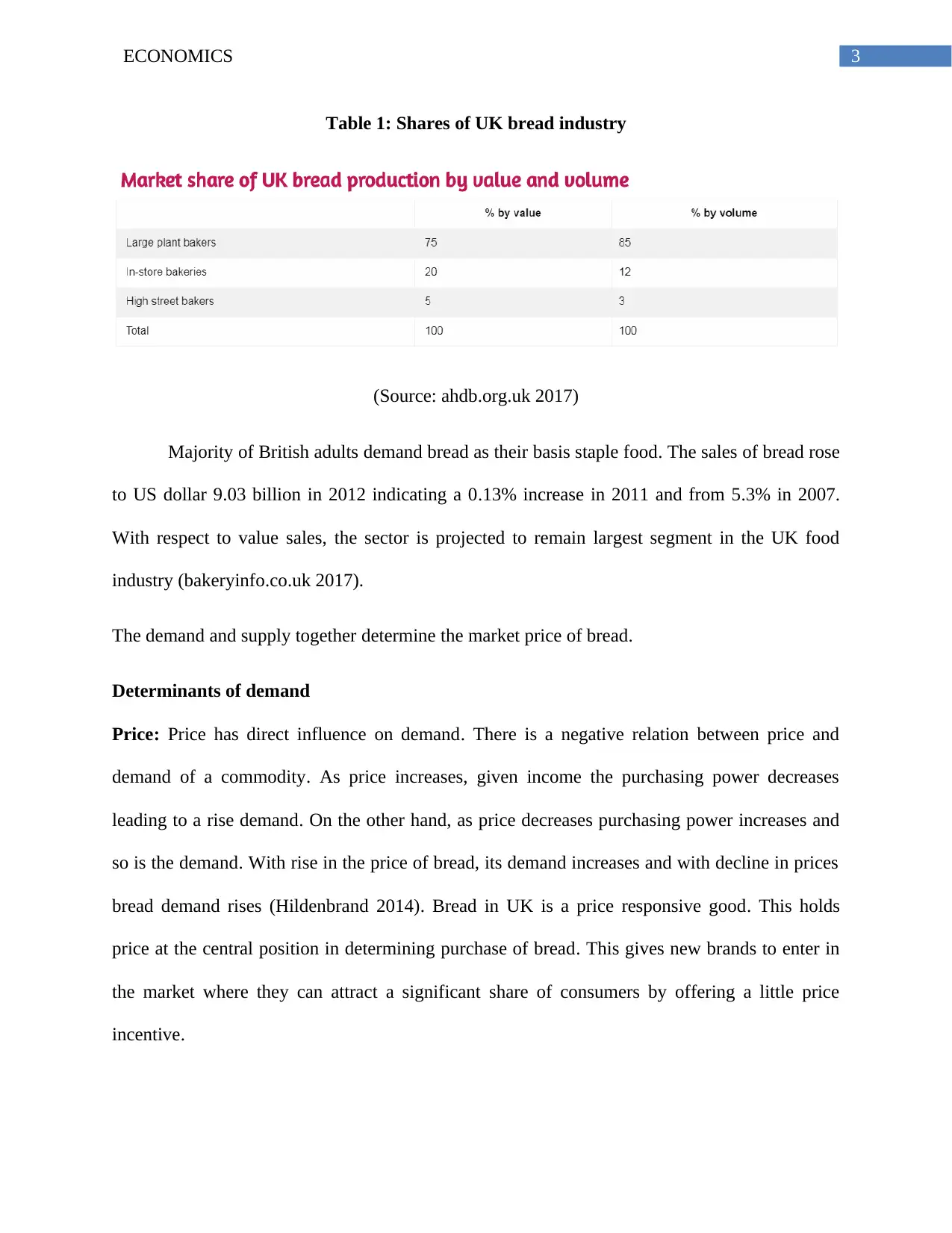
3ECONOMICS
Table 1: Shares of UK bread industry
(Source: ahdb.org.uk 2017)
Majority of British adults demand bread as their basis staple food. The sales of bread rose
to US dollar 9.03 billion in 2012 indicating a 0.13% increase in 2011 and from 5.3% in 2007.
With respect to value sales, the sector is projected to remain largest segment in the UK food
industry (bakeryinfo.co.uk 2017).
The demand and supply together determine the market price of bread.
Determinants of demand
Price: Price has direct influence on demand. There is a negative relation between price and
demand of a commodity. As price increases, given income the purchasing power decreases
leading to a rise demand. On the other hand, as price decreases purchasing power increases and
so is the demand. With rise in the price of bread, its demand increases and with decline in prices
bread demand rises (Hildenbrand 2014). Bread in UK is a price responsive good. This holds
price at the central position in determining purchase of bread. This gives new brands to enter in
the market where they can attract a significant share of consumers by offering a little price
incentive.
Table 1: Shares of UK bread industry
(Source: ahdb.org.uk 2017)
Majority of British adults demand bread as their basis staple food. The sales of bread rose
to US dollar 9.03 billion in 2012 indicating a 0.13% increase in 2011 and from 5.3% in 2007.
With respect to value sales, the sector is projected to remain largest segment in the UK food
industry (bakeryinfo.co.uk 2017).
The demand and supply together determine the market price of bread.
Determinants of demand
Price: Price has direct influence on demand. There is a negative relation between price and
demand of a commodity. As price increases, given income the purchasing power decreases
leading to a rise demand. On the other hand, as price decreases purchasing power increases and
so is the demand. With rise in the price of bread, its demand increases and with decline in prices
bread demand rises (Hildenbrand 2014). Bread in UK is a price responsive good. This holds
price at the central position in determining purchase of bread. This gives new brands to enter in
the market where they can attract a significant share of consumers by offering a little price
incentive.
Paraphrase This Document
Need a fresh take? Get an instant paraphrase of this document with our AI Paraphraser
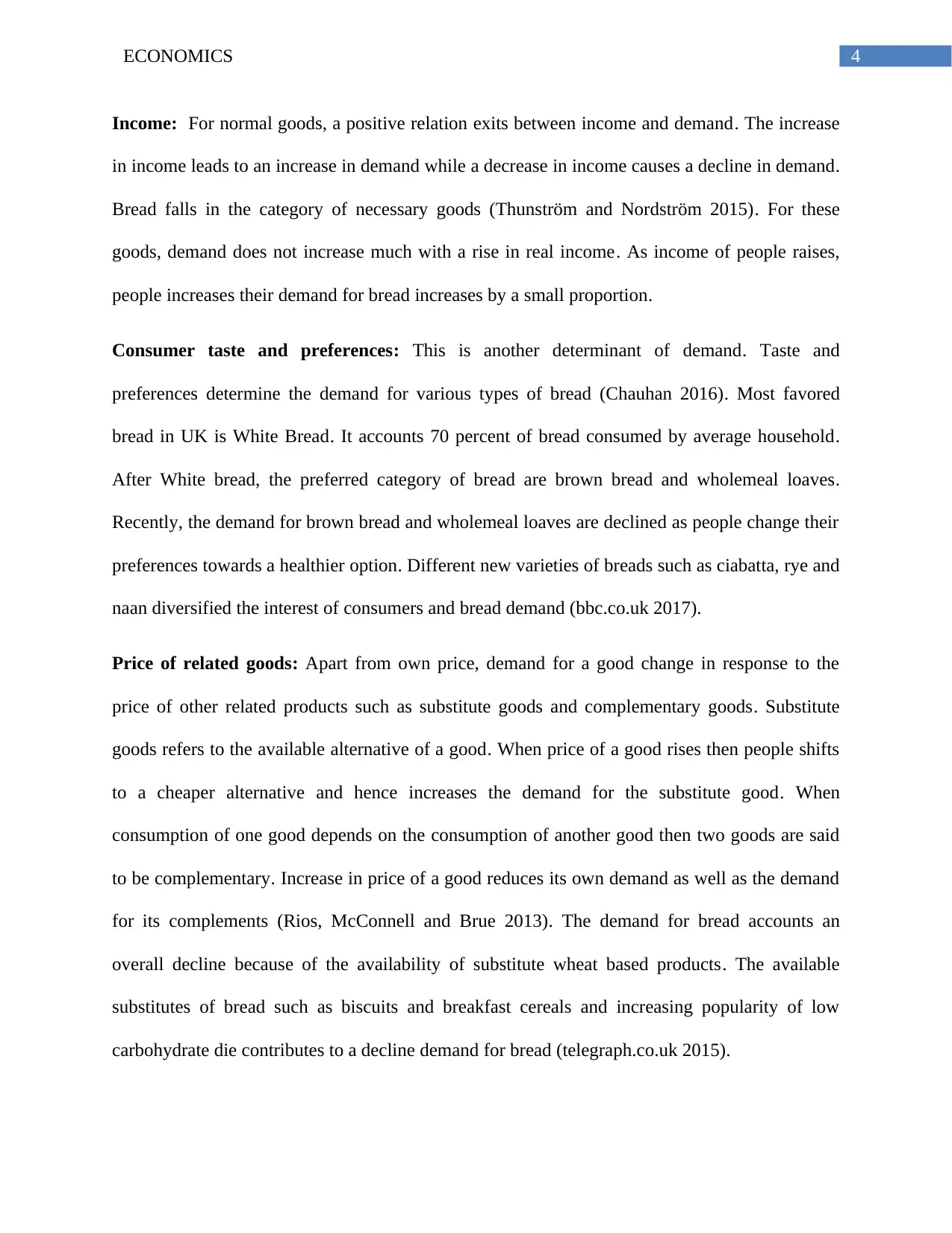
4ECONOMICS
Income: For normal goods, a positive relation exits between income and demand. The increase
in income leads to an increase in demand while a decrease in income causes a decline in demand.
Bread falls in the category of necessary goods (Thunström and Nordström 2015). For these
goods, demand does not increase much with a rise in real income. As income of people raises,
people increases their demand for bread increases by a small proportion.
Consumer taste and preferences: This is another determinant of demand. Taste and
preferences determine the demand for various types of bread (Chauhan 2016). Most favored
bread in UK is White Bread. It accounts 70 percent of bread consumed by average household.
After White bread, the preferred category of bread are brown bread and wholemeal loaves.
Recently, the demand for brown bread and wholemeal loaves are declined as people change their
preferences towards a healthier option. Different new varieties of breads such as ciabatta, rye and
naan diversified the interest of consumers and bread demand (bbc.co.uk 2017).
Price of related goods: Apart from own price, demand for a good change in response to the
price of other related products such as substitute goods and complementary goods. Substitute
goods refers to the available alternative of a good. When price of a good rises then people shifts
to a cheaper alternative and hence increases the demand for the substitute good. When
consumption of one good depends on the consumption of another good then two goods are said
to be complementary. Increase in price of a good reduces its own demand as well as the demand
for its complements (Rios, McConnell and Brue 2013). The demand for bread accounts an
overall decline because of the availability of substitute wheat based products. The available
substitutes of bread such as biscuits and breakfast cereals and increasing popularity of low
carbohydrate die contributes to a decline demand for bread (telegraph.co.uk 2015).
Income: For normal goods, a positive relation exits between income and demand. The increase
in income leads to an increase in demand while a decrease in income causes a decline in demand.
Bread falls in the category of necessary goods (Thunström and Nordström 2015). For these
goods, demand does not increase much with a rise in real income. As income of people raises,
people increases their demand for bread increases by a small proportion.
Consumer taste and preferences: This is another determinant of demand. Taste and
preferences determine the demand for various types of bread (Chauhan 2016). Most favored
bread in UK is White Bread. It accounts 70 percent of bread consumed by average household.
After White bread, the preferred category of bread are brown bread and wholemeal loaves.
Recently, the demand for brown bread and wholemeal loaves are declined as people change their
preferences towards a healthier option. Different new varieties of breads such as ciabatta, rye and
naan diversified the interest of consumers and bread demand (bbc.co.uk 2017).
Price of related goods: Apart from own price, demand for a good change in response to the
price of other related products such as substitute goods and complementary goods. Substitute
goods refers to the available alternative of a good. When price of a good rises then people shifts
to a cheaper alternative and hence increases the demand for the substitute good. When
consumption of one good depends on the consumption of another good then two goods are said
to be complementary. Increase in price of a good reduces its own demand as well as the demand
for its complements (Rios, McConnell and Brue 2013). The demand for bread accounts an
overall decline because of the availability of substitute wheat based products. The available
substitutes of bread such as biscuits and breakfast cereals and increasing popularity of low
carbohydrate die contributes to a decline demand for bread (telegraph.co.uk 2015).
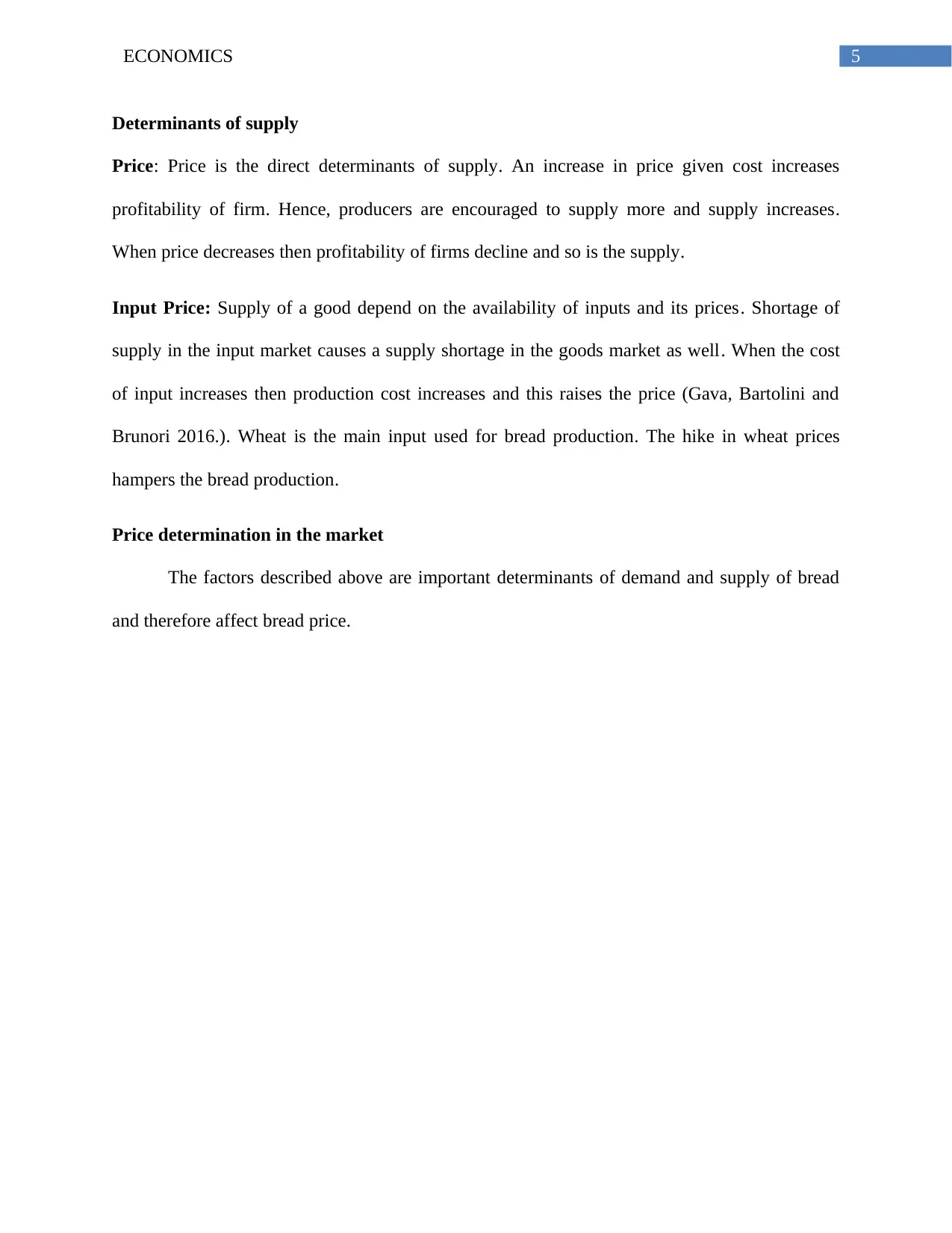
5ECONOMICS
Determinants of supply
Price: Price is the direct determinants of supply. An increase in price given cost increases
profitability of firm. Hence, producers are encouraged to supply more and supply increases.
When price decreases then profitability of firms decline and so is the supply.
Input Price: Supply of a good depend on the availability of inputs and its prices. Shortage of
supply in the input market causes a supply shortage in the goods market as well. When the cost
of input increases then production cost increases and this raises the price (Gava, Bartolini and
Brunori 2016.). Wheat is the main input used for bread production. The hike in wheat prices
hampers the bread production.
Price determination in the market
The factors described above are important determinants of demand and supply of bread
and therefore affect bread price.
Determinants of supply
Price: Price is the direct determinants of supply. An increase in price given cost increases
profitability of firm. Hence, producers are encouraged to supply more and supply increases.
When price decreases then profitability of firms decline and so is the supply.
Input Price: Supply of a good depend on the availability of inputs and its prices. Shortage of
supply in the input market causes a supply shortage in the goods market as well. When the cost
of input increases then production cost increases and this raises the price (Gava, Bartolini and
Brunori 2016.). Wheat is the main input used for bread production. The hike in wheat prices
hampers the bread production.
Price determination in the market
The factors described above are important determinants of demand and supply of bread
and therefore affect bread price.
⊘ This is a preview!⊘
Do you want full access?
Subscribe today to unlock all pages.

Trusted by 1+ million students worldwide
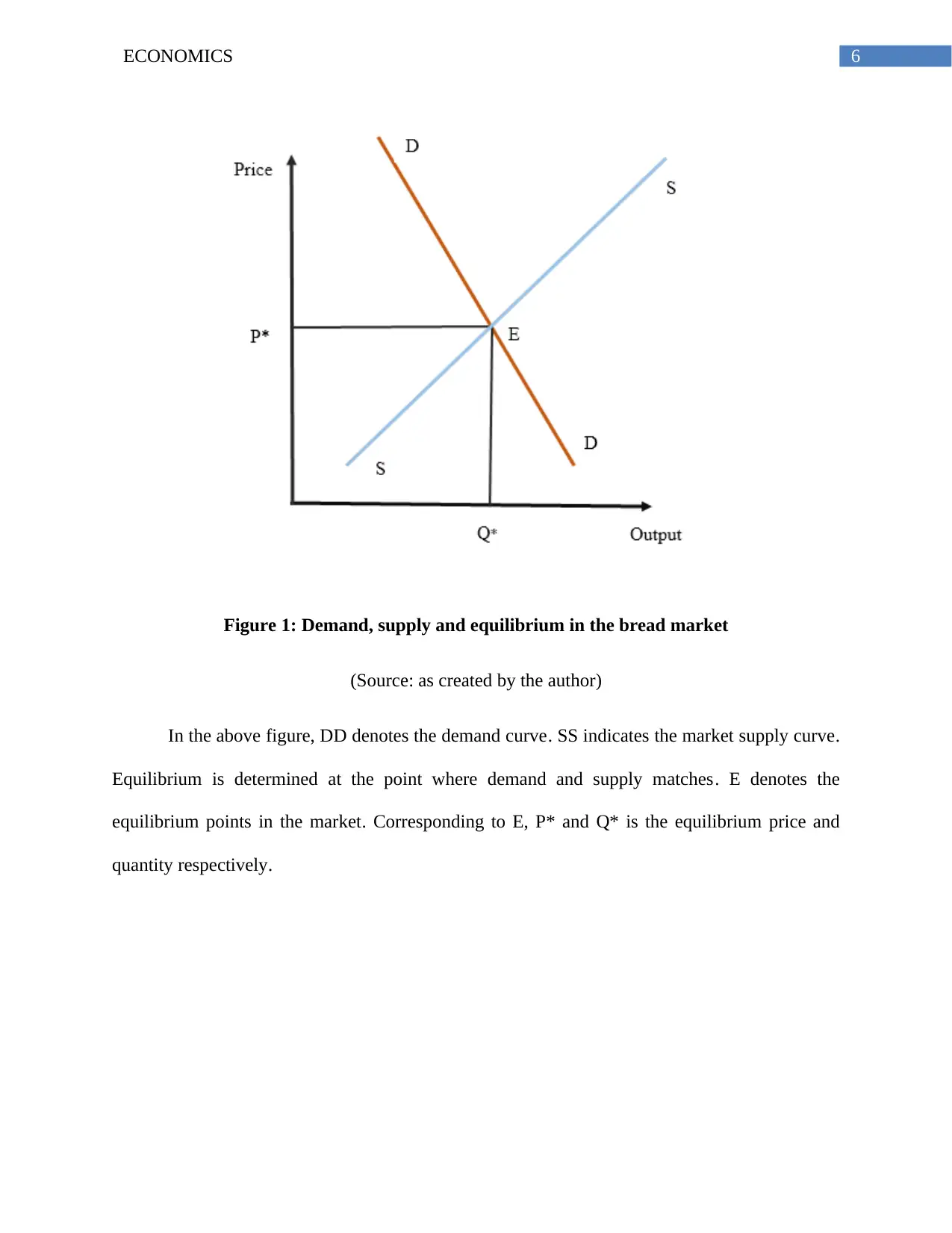
6ECONOMICS
Figure 1: Demand, supply and equilibrium in the bread market
(Source: as created by the author)
In the above figure, DD denotes the demand curve. SS indicates the market supply curve.
Equilibrium is determined at the point where demand and supply matches. E denotes the
equilibrium points in the market. Corresponding to E, P* and Q* is the equilibrium price and
quantity respectively.
Figure 1: Demand, supply and equilibrium in the bread market
(Source: as created by the author)
In the above figure, DD denotes the demand curve. SS indicates the market supply curve.
Equilibrium is determined at the point where demand and supply matches. E denotes the
equilibrium points in the market. Corresponding to E, P* and Q* is the equilibrium price and
quantity respectively.
Paraphrase This Document
Need a fresh take? Get an instant paraphrase of this document with our AI Paraphraser

7ECONOMICS
Figure 2: Contraction of demand and impact on price
(Source: as created by Author)
Bread manufacturers in UK has experienced a decline their demand following a price war
in the supermarket and shifts in dietary habit towards a fresh alternative. The main driving factor
for declining bread demand is introduction of alternative morning products and the other grain
style loaves regarded as a healthy alternative. The decreased demand also attributed from a
decline in lunch packed to schools. This is due to adaption of free meals in schools for student
students of five to seven years old.
Figure 2: Contraction of demand and impact on price
(Source: as created by Author)
Bread manufacturers in UK has experienced a decline their demand following a price war
in the supermarket and shifts in dietary habit towards a fresh alternative. The main driving factor
for declining bread demand is introduction of alternative morning products and the other grain
style loaves regarded as a healthy alternative. The decreased demand also attributed from a
decline in lunch packed to schools. This is due to adaption of free meals in schools for student
students of five to seven years old.

8ECONOMICS
Decline demand of bread reduces the price for bread. The mechanism is described in
figure 2 using framework for demand and supply. Change in demand due to determinants other
than price causes a shift in the demand curve. The decrease demand is shown by a leftward shift
of the demand curve. The new equilibrium is obtained where the new demand curve cuts the
existing supply curve. The new equilibrium price is P1, which is lower than the previous price.
Consequently, the equilibrium quantity is set at a lower level denoted as Q1. The demand decline
is a good news for bread lovers. The reduced demand causes a heavy decline in price of loaves
available in High Street Stores. In case of a large loaf price reduced on an average by 15p
(birmingham.ac.uk 2017).
Economic policies to control obesity in UK
Obesity has now become a cause of concern for almost all age groups. In medical terms,
obesity is defined a condition of body where too much fat accumulated in body and affect human
health in different ways. There is index called Body Mass Index that is used to identify whether a
person is suffering from obesity or not. People having problem of obesity are more prone to
disease like type 2 diabetes, cardiovascular disease, obstructive sleep apnea and increases likely
cause of different types of cancer, depression, osteoarthritis and others (World Health
Organization 2017). The common cause of obesity is excessive intake of food without any
physical activity.
Obesity in UK
The problem of obesity is now at the central of all health hazards. In the euro zones, UK
has the highest obesity rate. The incidence of obesity had drastically increased in the last few
years. More than 20 percent of population is now come under the obese range. The health cost in
the economy has increased drastically. UK economy has now spent nearly £ 3 billion annually.
Decline demand of bread reduces the price for bread. The mechanism is described in
figure 2 using framework for demand and supply. Change in demand due to determinants other
than price causes a shift in the demand curve. The decrease demand is shown by a leftward shift
of the demand curve. The new equilibrium is obtained where the new demand curve cuts the
existing supply curve. The new equilibrium price is P1, which is lower than the previous price.
Consequently, the equilibrium quantity is set at a lower level denoted as Q1. The demand decline
is a good news for bread lovers. The reduced demand causes a heavy decline in price of loaves
available in High Street Stores. In case of a large loaf price reduced on an average by 15p
(birmingham.ac.uk 2017).
Economic policies to control obesity in UK
Obesity has now become a cause of concern for almost all age groups. In medical terms,
obesity is defined a condition of body where too much fat accumulated in body and affect human
health in different ways. There is index called Body Mass Index that is used to identify whether a
person is suffering from obesity or not. People having problem of obesity are more prone to
disease like type 2 diabetes, cardiovascular disease, obstructive sleep apnea and increases likely
cause of different types of cancer, depression, osteoarthritis and others (World Health
Organization 2017). The common cause of obesity is excessive intake of food without any
physical activity.
Obesity in UK
The problem of obesity is now at the central of all health hazards. In the euro zones, UK
has the highest obesity rate. The incidence of obesity had drastically increased in the last few
years. More than 20 percent of population is now come under the obese range. The health cost in
the economy has increased drastically. UK economy has now spent nearly £ 3 billion annually.
⊘ This is a preview!⊘
Do you want full access?
Subscribe today to unlock all pages.

Trusted by 1+ million students worldwide
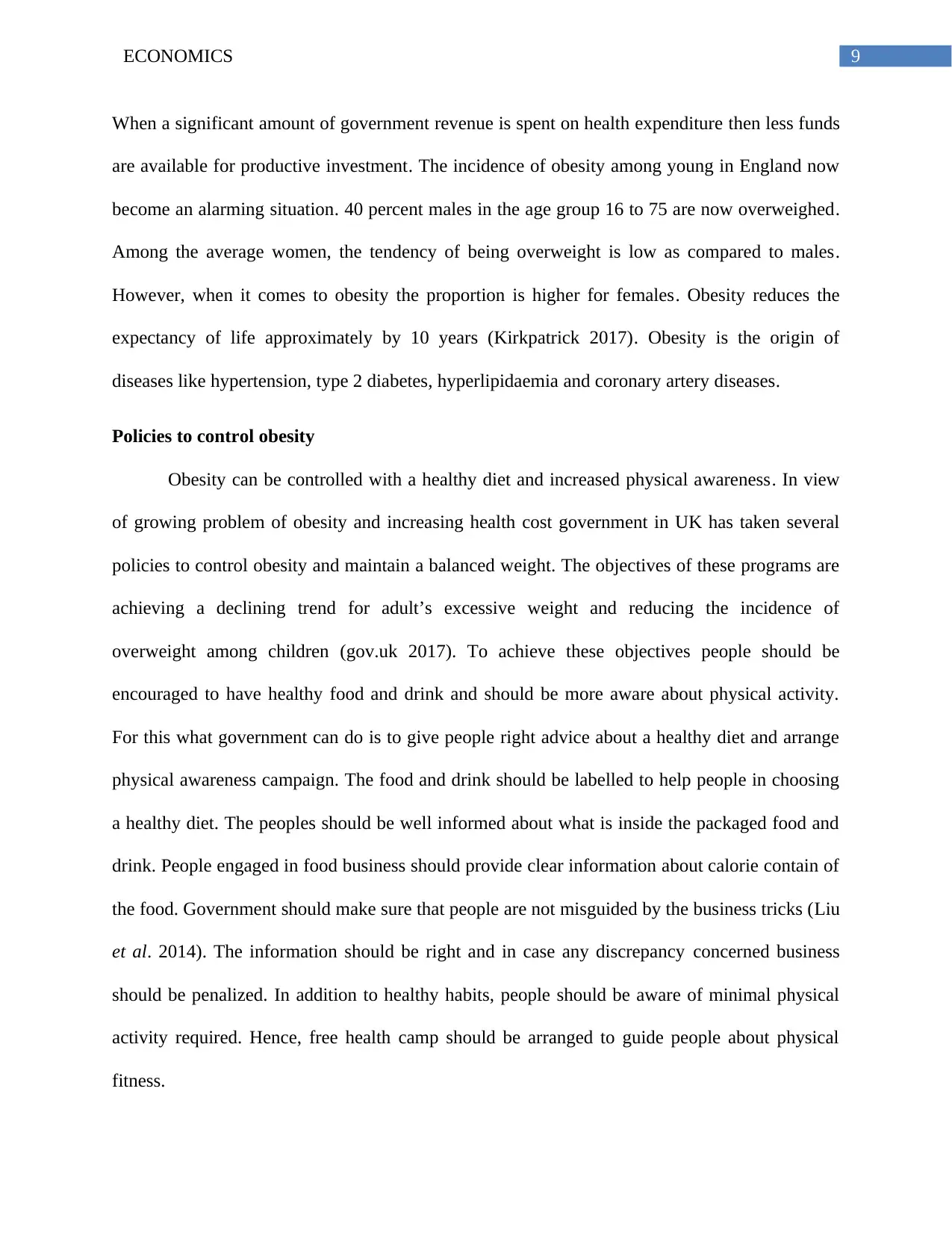
9ECONOMICS
When a significant amount of government revenue is spent on health expenditure then less funds
are available for productive investment. The incidence of obesity among young in England now
become an alarming situation. 40 percent males in the age group 16 to 75 are now overweighed.
Among the average women, the tendency of being overweight is low as compared to males.
However, when it comes to obesity the proportion is higher for females. Obesity reduces the
expectancy of life approximately by 10 years (Kirkpatrick 2017). Obesity is the origin of
diseases like hypertension, type 2 diabetes, hyperlipidaemia and coronary artery diseases.
Policies to control obesity
Obesity can be controlled with a healthy diet and increased physical awareness. In view
of growing problem of obesity and increasing health cost government in UK has taken several
policies to control obesity and maintain a balanced weight. The objectives of these programs are
achieving a declining trend for adult’s excessive weight and reducing the incidence of
overweight among children (gov.uk 2017). To achieve these objectives people should be
encouraged to have healthy food and drink and should be more aware about physical activity.
For this what government can do is to give people right advice about a healthy diet and arrange
physical awareness campaign. The food and drink should be labelled to help people in choosing
a healthy diet. The peoples should be well informed about what is inside the packaged food and
drink. People engaged in food business should provide clear information about calorie contain of
the food. Government should make sure that people are not misguided by the business tricks (Liu
et al. 2014). The information should be right and in case any discrepancy concerned business
should be penalized. In addition to healthy habits, people should be aware of minimal physical
activity required. Hence, free health camp should be arranged to guide people about physical
fitness.
When a significant amount of government revenue is spent on health expenditure then less funds
are available for productive investment. The incidence of obesity among young in England now
become an alarming situation. 40 percent males in the age group 16 to 75 are now overweighed.
Among the average women, the tendency of being overweight is low as compared to males.
However, when it comes to obesity the proportion is higher for females. Obesity reduces the
expectancy of life approximately by 10 years (Kirkpatrick 2017). Obesity is the origin of
diseases like hypertension, type 2 diabetes, hyperlipidaemia and coronary artery diseases.
Policies to control obesity
Obesity can be controlled with a healthy diet and increased physical awareness. In view
of growing problem of obesity and increasing health cost government in UK has taken several
policies to control obesity and maintain a balanced weight. The objectives of these programs are
achieving a declining trend for adult’s excessive weight and reducing the incidence of
overweight among children (gov.uk 2017). To achieve these objectives people should be
encouraged to have healthy food and drink and should be more aware about physical activity.
For this what government can do is to give people right advice about a healthy diet and arrange
physical awareness campaign. The food and drink should be labelled to help people in choosing
a healthy diet. The peoples should be well informed about what is inside the packaged food and
drink. People engaged in food business should provide clear information about calorie contain of
the food. Government should make sure that people are not misguided by the business tricks (Liu
et al. 2014). The information should be right and in case any discrepancy concerned business
should be penalized. In addition to healthy habits, people should be aware of minimal physical
activity required. Hence, free health camp should be arranged to guide people about physical
fitness.
Paraphrase This Document
Need a fresh take? Get an instant paraphrase of this document with our AI Paraphraser
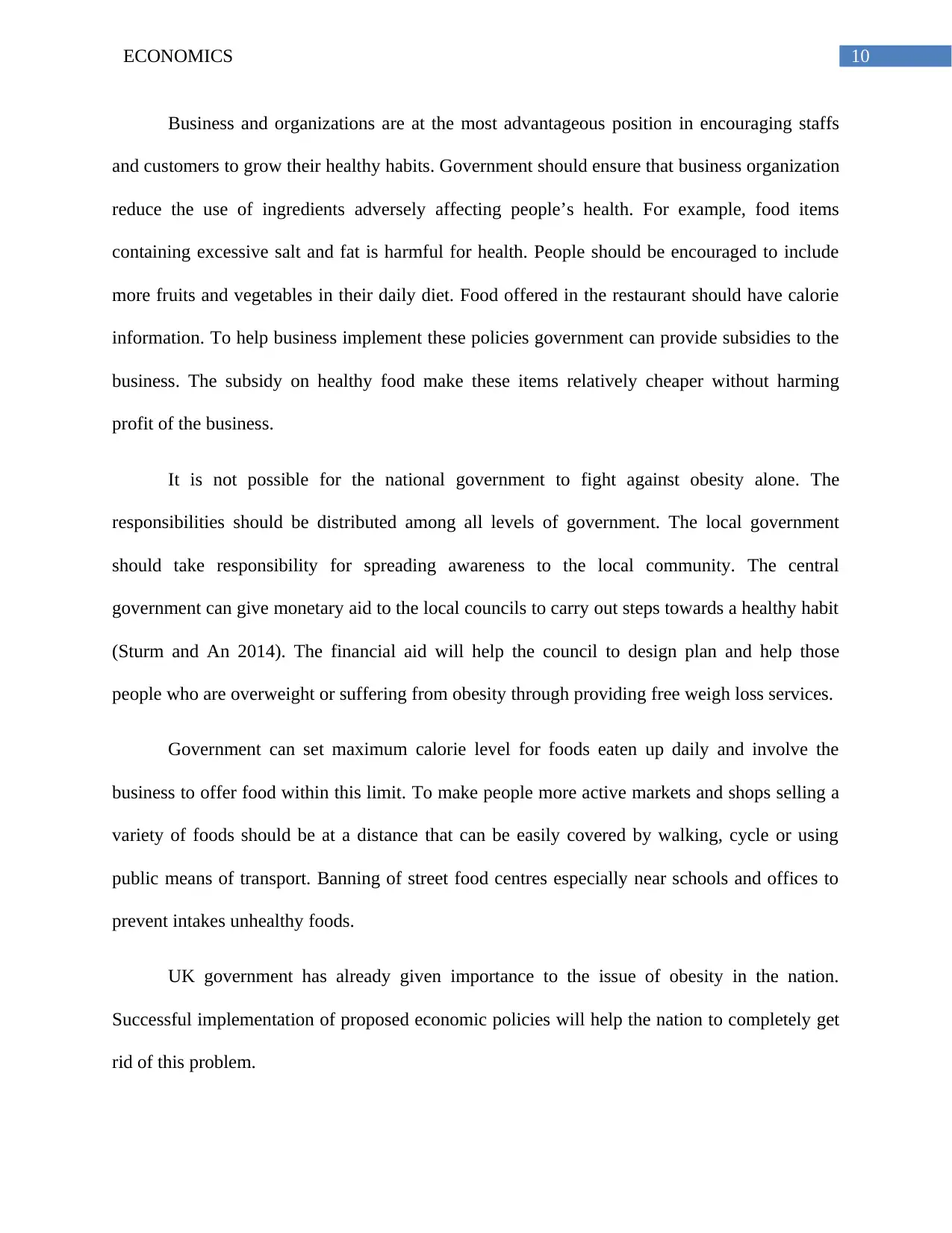
10ECONOMICS
Business and organizations are at the most advantageous position in encouraging staffs
and customers to grow their healthy habits. Government should ensure that business organization
reduce the use of ingredients adversely affecting people’s health. For example, food items
containing excessive salt and fat is harmful for health. People should be encouraged to include
more fruits and vegetables in their daily diet. Food offered in the restaurant should have calorie
information. To help business implement these policies government can provide subsidies to the
business. The subsidy on healthy food make these items relatively cheaper without harming
profit of the business.
It is not possible for the national government to fight against obesity alone. The
responsibilities should be distributed among all levels of government. The local government
should take responsibility for spreading awareness to the local community. The central
government can give monetary aid to the local councils to carry out steps towards a healthy habit
(Sturm and An 2014). The financial aid will help the council to design plan and help those
people who are overweight or suffering from obesity through providing free weigh loss services.
Government can set maximum calorie level for foods eaten up daily and involve the
business to offer food within this limit. To make people more active markets and shops selling a
variety of foods should be at a distance that can be easily covered by walking, cycle or using
public means of transport. Banning of street food centres especially near schools and offices to
prevent intakes unhealthy foods.
UK government has already given importance to the issue of obesity in the nation.
Successful implementation of proposed economic policies will help the nation to completely get
rid of this problem.
Business and organizations are at the most advantageous position in encouraging staffs
and customers to grow their healthy habits. Government should ensure that business organization
reduce the use of ingredients adversely affecting people’s health. For example, food items
containing excessive salt and fat is harmful for health. People should be encouraged to include
more fruits and vegetables in their daily diet. Food offered in the restaurant should have calorie
information. To help business implement these policies government can provide subsidies to the
business. The subsidy on healthy food make these items relatively cheaper without harming
profit of the business.
It is not possible for the national government to fight against obesity alone. The
responsibilities should be distributed among all levels of government. The local government
should take responsibility for spreading awareness to the local community. The central
government can give monetary aid to the local councils to carry out steps towards a healthy habit
(Sturm and An 2014). The financial aid will help the council to design plan and help those
people who are overweight or suffering from obesity through providing free weigh loss services.
Government can set maximum calorie level for foods eaten up daily and involve the
business to offer food within this limit. To make people more active markets and shops selling a
variety of foods should be at a distance that can be easily covered by walking, cycle or using
public means of transport. Banning of street food centres especially near schools and offices to
prevent intakes unhealthy foods.
UK government has already given importance to the issue of obesity in the nation.
Successful implementation of proposed economic policies will help the nation to completely get
rid of this problem.
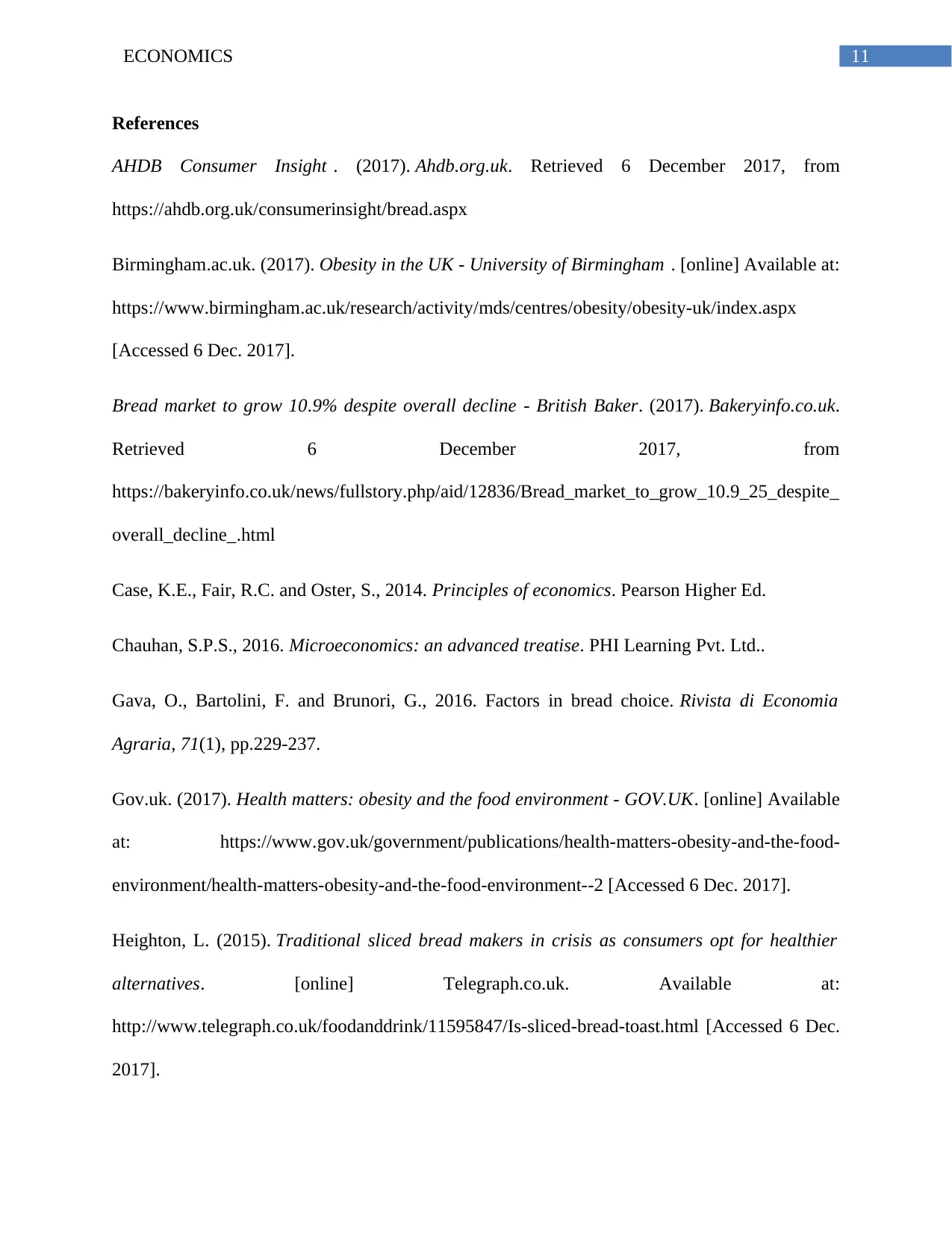
11ECONOMICS
References
AHDB Consumer Insight . (2017). Ahdb.org.uk. Retrieved 6 December 2017, from
https://ahdb.org.uk/consumerinsight/bread.aspx
Birmingham.ac.uk. (2017). Obesity in the UK - University of Birmingham . [online] Available at:
https://www.birmingham.ac.uk/research/activity/mds/centres/obesity/obesity-uk/index.aspx
[Accessed 6 Dec. 2017].
Bread market to grow 10.9% despite overall decline - British Baker. (2017). Bakeryinfo.co.uk.
Retrieved 6 December 2017, from
https://bakeryinfo.co.uk/news/fullstory.php/aid/12836/Bread_market_to_grow_10.9_25_despite_
overall_decline_.html
Case, K.E., Fair, R.C. and Oster, S., 2014. Principles of economics. Pearson Higher Ed.
Chauhan, S.P.S., 2016. Microeconomics: an advanced treatise. PHI Learning Pvt. Ltd..
Gava, O., Bartolini, F. and Brunori, G., 2016. Factors in bread choice. Rivista di Economia
Agraria, 71(1), pp.229-237.
Gov.uk. (2017). Health matters: obesity and the food environment - GOV.UK. [online] Available
at: https://www.gov.uk/government/publications/health-matters-obesity-and-the-food-
environment/health-matters-obesity-and-the-food-environment--2 [Accessed 6 Dec. 2017].
Heighton, L. (2015). Traditional sliced bread makers in crisis as consumers opt for healthier
alternatives. [online] Telegraph.co.uk. Available at:
http://www.telegraph.co.uk/foodanddrink/11595847/Is-sliced-bread-toast.html [Accessed 6 Dec.
2017].
References
AHDB Consumer Insight . (2017). Ahdb.org.uk. Retrieved 6 December 2017, from
https://ahdb.org.uk/consumerinsight/bread.aspx
Birmingham.ac.uk. (2017). Obesity in the UK - University of Birmingham . [online] Available at:
https://www.birmingham.ac.uk/research/activity/mds/centres/obesity/obesity-uk/index.aspx
[Accessed 6 Dec. 2017].
Bread market to grow 10.9% despite overall decline - British Baker. (2017). Bakeryinfo.co.uk.
Retrieved 6 December 2017, from
https://bakeryinfo.co.uk/news/fullstory.php/aid/12836/Bread_market_to_grow_10.9_25_despite_
overall_decline_.html
Case, K.E., Fair, R.C. and Oster, S., 2014. Principles of economics. Pearson Higher Ed.
Chauhan, S.P.S., 2016. Microeconomics: an advanced treatise. PHI Learning Pvt. Ltd..
Gava, O., Bartolini, F. and Brunori, G., 2016. Factors in bread choice. Rivista di Economia
Agraria, 71(1), pp.229-237.
Gov.uk. (2017). Health matters: obesity and the food environment - GOV.UK. [online] Available
at: https://www.gov.uk/government/publications/health-matters-obesity-and-the-food-
environment/health-matters-obesity-and-the-food-environment--2 [Accessed 6 Dec. 2017].
Heighton, L. (2015). Traditional sliced bread makers in crisis as consumers opt for healthier
alternatives. [online] Telegraph.co.uk. Available at:
http://www.telegraph.co.uk/foodanddrink/11595847/Is-sliced-bread-toast.html [Accessed 6 Dec.
2017].
⊘ This is a preview!⊘
Do you want full access?
Subscribe today to unlock all pages.

Trusted by 1+ million students worldwide
1 out of 13
Related Documents
Your All-in-One AI-Powered Toolkit for Academic Success.
+13062052269
info@desklib.com
Available 24*7 on WhatsApp / Email
![[object Object]](/_next/static/media/star-bottom.7253800d.svg)
Unlock your academic potential
Copyright © 2020–2025 A2Z Services. All Rights Reserved. Developed and managed by ZUCOL.





